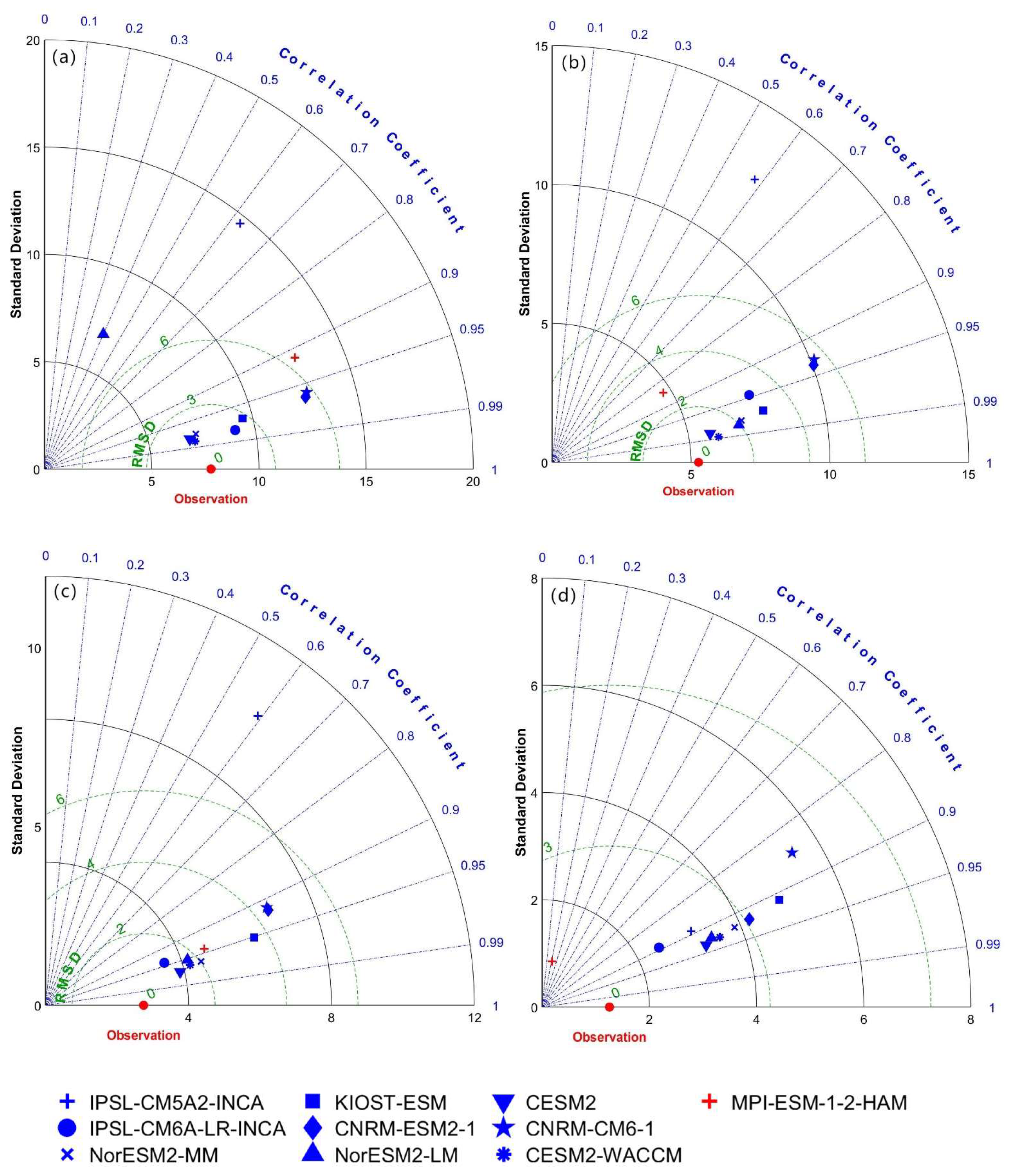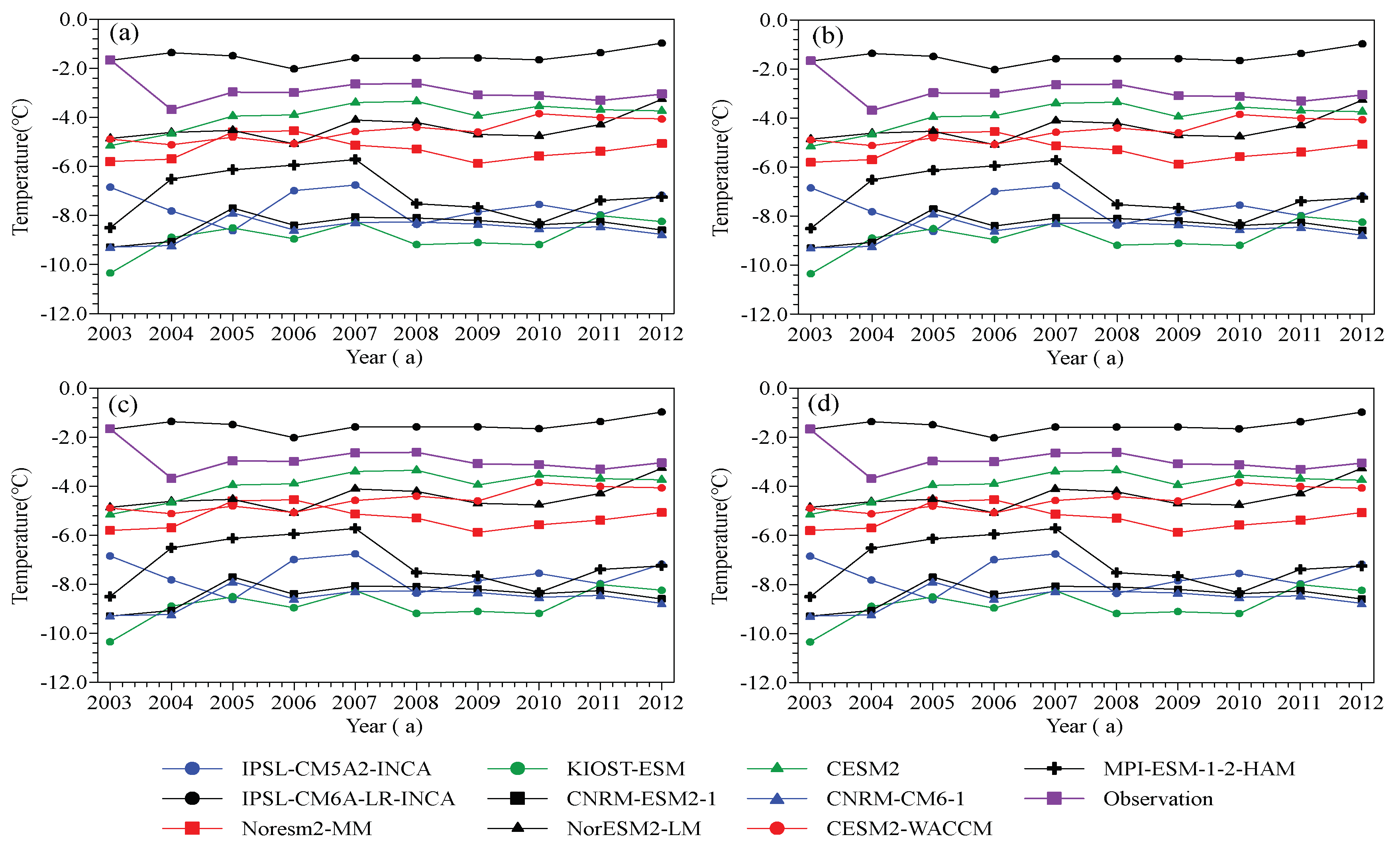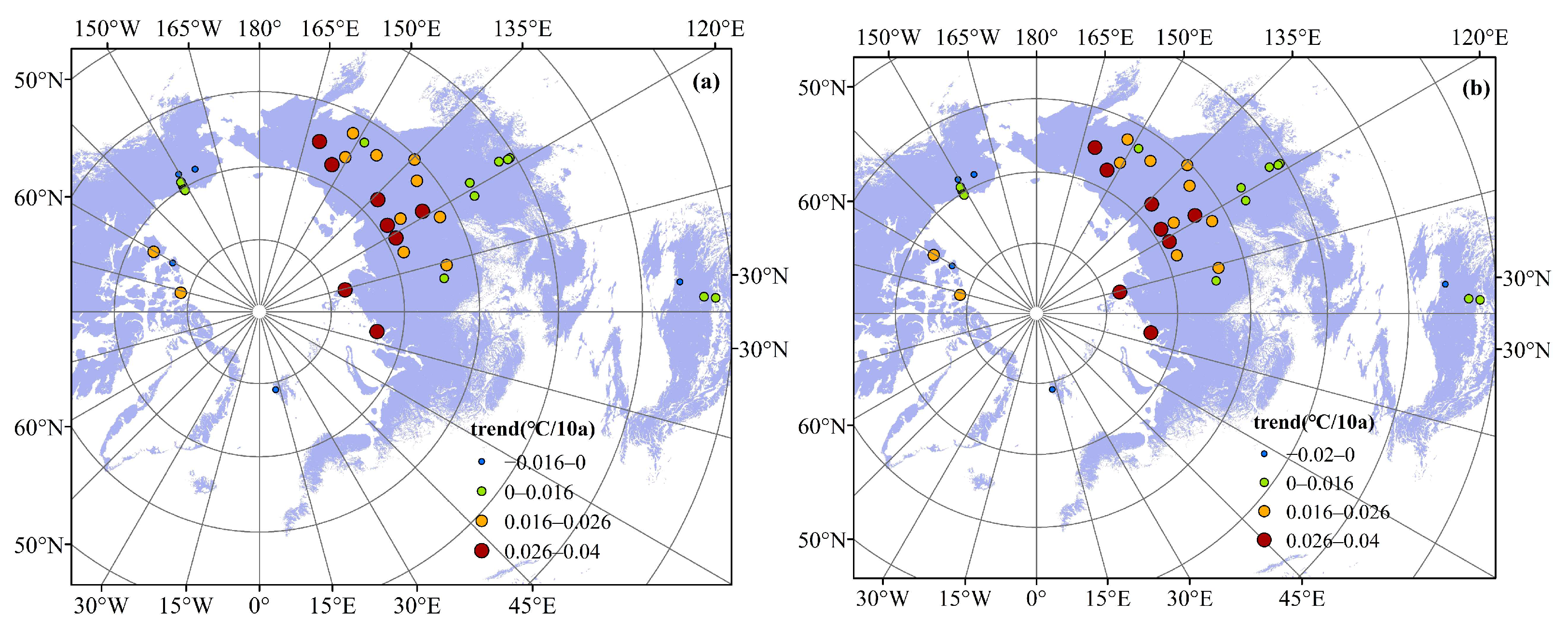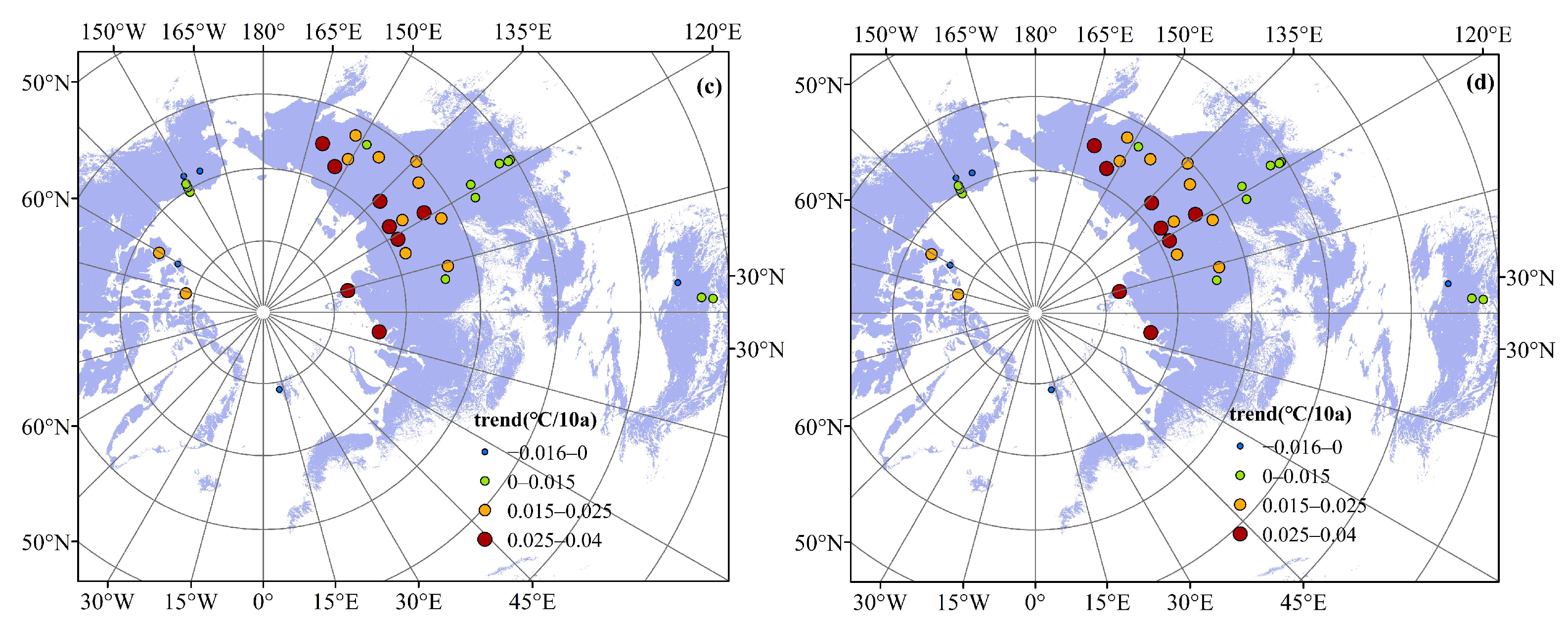Assessment of Soil Temperature and Its Change Trends in the Permafrost Regions of the Northern Hemisphere
Abstract
:1. Introduction
2. Data and Methods
2.1. Data Sources
2.2. Taylor Diagrams Analysis Method
3. Results
3.1. Spatial Distribution Characteristics of Soil Temperature
3.2. Assessment of CMIP6 Models
3.3. Changes in Soil Temperature at Different Depths between Different Sites
3.4. Trends of Soil Temperature in the Northern Hemisphere
4. Discussion
5. Conclusions
- (1)
- The annual mean soil temperature in the permafrost region of the Northern Hemisphere gradually decreased with increasing latitude, with the lower soil temperatures near the Arctic. The spatial distribution of annual average soil temperatures did not vary much among different depths, and most of the soil temperatures in the 0–50 cm and 50–100 cm layers were concentrated around −1 °C. Those of the 100–200 cm and 200–300 cm layers were mainly concentrated around −0.5 °C.
- (2)
- All 10 examined CMIP6 models exhibited good soil temperature simulation abilities. Comparing the simulated and observed data, all models had correlation coefficients greater than 0.9, RMS error between 2.19 °C and 9.62 °C, standard deviation between 4.96 °C and 10.08 °C, and MAE from 1.72 °C to 8.74 °C, with a mean value of 4.9 °C. Most of the models underestimated the soil temperature. Among the 10 models, the IPLS-CM6A-LR-INCA simulated data and change trends were closest to the measured values, while the values from the KIOST-ESM model were furthest from the measured data. There were large differences in the simulations of different models. The comprehensive ranking of each model showed that the CESM2 model had the best simulation effect, CNRM-CM6-1 had the worst, and the average of the top three optimal models produces even better simulation results, indicating that multi-model averaging can effectively reduce the uncertainty of a single-model simulation in CMIP6.
- (3)
- The change trends in annual mean soil temperature at the 42 sites ranged between −0.17 °C/10a and 0.41 °C/10a, with most (98%) sites showing significant warming trends (p < 0.05) and greater rates of change at sites closer to the Arctic Circle. In 1900–2014 and 1980–2014, soil temperatures in the Northern Hemisphere all showed warming trends. The rate of soil temperature change in the past 35 years was about three times greater than that in the past 115 years.
Author Contributions
Funding
Data Availability Statement
Acknowledgments
Conflicts of Interest
References
- Subcommittee, P. Glossary of Permafrost and Related Ground-Ice Terms; Associate Committee on Geotechnical Research, National Research Council of Canada: Ottawa, ON, Canada, 1988; Volume 156, pp. 63–64. [Google Scholar]
- Obu, J.; Westermann, S.; Bartsch, A.; Berdnikov, N.; Christiansen, H.H.; Dashtseren, A.; Delaloye, R.; Elberling, B.; Etzelmueller, B.; Kholodov, A.; et al. Northern Hemisphere permafrost map based on TTOP modelling for 2000–2016 at 1 km2 scale. Earth-Sci. Rev. 2019, 193, 299–316. [Google Scholar] [CrossRef]
- Cheng, G.; Zhao, L.; Li, R.; Wu, X.; Sheng, Y.; Hu, G.; Zou, D.; Jin, H.; Li, X.; Wu, Q. Characteristic, changes and impacts of permafrost on Qinghai-Tibet Plateau. Chin. Sci. Bull. 2019, 64, 2783–2795. [Google Scholar]
- Schuur, E.A.G.; McGuire, A.D.; Schädel, C.; Grosse, G.; Harden, J.W.; Hayes, D.J.; Hugelius, G.; Koven, C.D.; Kuhry, P.; Lawrence, D.M.; et al. Climate change and the permafrost carbon feedback. Nature 2015, 520, 171–179. [Google Scholar] [CrossRef] [PubMed]
- Wrona, F.J.; Johansson, M.; Culp, J.M.; Jenkins, A.; Mård, J.; Myers-Smith, I.H.; Prowse, T.D.; Vincent, W.F.; Wookey, P.A. Transitions in Arctic ecosystems: Ecological implications of a changing hydrological regime. J. Geophys. Res.-Biogeosci. 2016, 121, 650–674. [Google Scholar] [CrossRef]
- Zhao, L.; Hu, G.; Zou, D.; Wu, X.; Ma, L.; Sun, Z.; Yuan, L.; Zhou, H.; Liu, S. Permafrost Changes and Its Effects on Hydrological Processes on Qinghai-Tibet Plateau. Bull. Chin. Acad. Sci. 2019, 34, 1233–1246. [Google Scholar]
- Ding, Y.J.; Zhang, S.Q.; Zhao, L.; Li, Z.Q.; Kang, S.C. Global warming weakening the inherent stability of glaciers and permafrost. Sci. Bull. 2019, 64, 245–253. [Google Scholar] [CrossRef] [PubMed]
- Gruber, S. Ground subsidence and heave over permafrost: Hourly time series reveal interannual, seasonal and shorter-term movement caused by freezing, thawing and water movement. Cryosphere 2020, 14, 1437–1447. [Google Scholar] [CrossRef]
- Romanovsky, V.E.; Drozdov, D.S.; Oberman, N.G.; Malkova, G.V.; Kholodov, A.L.; Marchenko, S.S.; Moskalenko, N.G.; Sergeev, D.O.; Ukraintseva, N.G.; Abramov, A.A.; et al. Thermal State of Permafrost in Russia. Permafr. Periglac. Process. 2010, 21, 136–155. [Google Scholar] [CrossRef]
- Qin, D. Climate change science and sustainable development. Prog. Geogr. 2014, 33, 874–883. [Google Scholar]
- Smith, S.L.; Romanovsky, V.E.; Lewkowicz, A.G.; Burn, C.R.; Allard, M.; Clow, G.D.; Yoshikawa, K.; Throop, J. Thermal State of Permafrost in North America: A Contribution to the International Polar Year. Permafr. Periglac. Process. 2010, 21, 117–135. [Google Scholar] [CrossRef]
- Romanovsky, V.E.; Smith, S.L.; Christiansen, H.H. Permafrost Thermal State in the Polar Northern Hemisphere during the International Polar Year 2007-2009: A Synthesis. Permafr. Periglac. Process. 2010, 21, 106–116. [Google Scholar] [CrossRef]
- Osterkamp, T.E. Establishing long-term permafrost observatories for active-layer and permafrost investigations in Alaska: 1977–2002. Permafr. Periglac. Process. 2003, 14, 331–342. [Google Scholar] [CrossRef]
- Fang, X.W.; Luo, S.Q.; Lyu, S.H. Observed soil temperature trends associated with climate change in the Tibetan Plateau, 1960–2014. Theor. Appl. Climatol. 2019, 135, 169–181. [Google Scholar] [CrossRef]
- Wu, Q.; Zhang, T.; Liu, Y. Thermal state of the active layer and permafrost along the Qinghai-Xizang (Tibet) Railway from 2006 to 2010. Cryosphere 2012, 6, 607–612. [Google Scholar] [CrossRef]
- Aalto, J.; Karjalainen, O.; Hjort, J.; Luoto, M. Statistical Forecasting of Current and Future Circum-Arctic Ground Temperatures and Active Layer Thickness. Geophys. Res. Lett. 2018, 45, 4889–4898. [Google Scholar] [CrossRef]
- Ni, J.; Wu, T.H.; Zhu, X.F.; Hu, G.J.; Zou, D.F.; Wu, X.D.; Li, R.; Xie, C.W.; Qiao, Y.P.; Pang, Q.Q.; et al. Simulation of the Present and Future Projection of Permafrost on the Qinghai-Tibet Plateau with Statistical and Machine Learning Models. J. Geophys. Res.-Atmos. 2021, 126, 20. [Google Scholar] [CrossRef]
- Kim, J.-E.; Alexander, M.J. Tropical precipitation variability and convectively coupled equatorial waves on submonthly time scales in reanalyses and TRMM. J. Clim. 2013, 26, 3013–3030. [Google Scholar] [CrossRef]
- Zhang, J.; Wang, W.C.; Wei, J. Assessing land-atmosphere coupling using soil moisture from the Global Land Data Assimilation System and observational precipitation. J. Geophys. Res. Atmos. 2008, 113, D17. [Google Scholar] [CrossRef]
- Chang, Y.; Lyu, S.; Luo, S.; Wu, J.; Li, R.; Li, S. Evaluation and Projections of Permafrost on the Qinghai-Xizang Plateau by CMIP5 Coupled Climate Models. Plateau Meteorol. 2016, 35, 1157–1168. [Google Scholar]
- Qin, Y.; Wu, T.; Li, R.; Xie, C.; Qiao, Y.; Chen, H.; Zou, D.; Zhang, L. Application of ERA Product of Land Surface Temperature in Permafrost Regions of Qinghai-Xizang Plateau. Plateau Meteorol. 2015, 34, 666–675. [Google Scholar]
- Albergel, C.; Dutra, E.; Muñoz-Sabater, J.; Haiden, T.; Balsamo, G.; Beljaars, A.; Isaksen, L.; de Rosnay, P.; Sandu, I.; Wedi, N. Soil temperature at ECMWF: An assessment using ground-based observations. J. Geophys. Res. Atmos. 2015, 120, 1361–1373. [Google Scholar] [CrossRef]
- Ding, X.; Lai, X.; Fan, G.; Wen, J.; Yuan, Y.; Wang, X.; Wang, Z.; Zhu, L.; Zhang, Y.; Wang, B. Analysis on the Applicability of Reanalysis Soil Temperature and Moisture Datasets over Qinghai-Tibetan Plateau. Plateau Meteorol. 2018, 37, 626–641. [Google Scholar]
- Li, R.; Shihua, L.U.; Han, b.; Gao, Y. Preliminary Comparison and Analyses of Air Temperature at 2 m Height between Three Reanalysis Data-Sets and Observation in the East of Qinghai-Xiang Plateau. Plateau Meteorol. 2012, 31, 1488–1502. [Google Scholar]
- Liu, C.; Yu, Y.; Xie, J.; Zhou, X.; Li, J.; Ge, J. Applicability of Soil Temperature and Moisture in Several Datasets over Qinghai-Xizang Plateau. Plateau Meteorol. 2015, 34, 653–665. [Google Scholar]
- Zhu, Z.; Shi, C.; Zhang, T.; Wang, J. Applicability Analysis of Four Soil Moisture Reanalysis Datasets in China. Plateau Meteorol. 2018, 37, 240–252. [Google Scholar]
- Chenghai, W.; Yongpingg, W.U.; Yang, C.U.I. Evaluating the Progress of the CMIP and Its Application Prospect in China. Adv. Earth Sci. 2009, 24, 461–468. [Google Scholar]
- Covey, C.; AchutaRao, K.M.; Cubasch, U.; Jones, P.; Lambert, S.J.; Mann, M.E.; Phillips, T.J.; Taylor, K.E. An overview of results from the Coupled Model Intercomparison Project. Glob. Planet. Change 2003, 37, 103–133. [Google Scholar] [CrossRef]
- Fan, X.; Miao, C.; Gou, J.; Wu, Y.; Zhang, Q. Coupled Model Intercomparison Project and its research progress in simulation performance. Prog. Geogr. 2023, 42, 1204–1215. [Google Scholar] [CrossRef]
- Xing, Z.P.; Zhao, L.; Fan, L.; Hu, G.-J.; Zou, D.-F.; Wang, C.; Liu, S.-C.; Du, E.-J.; Xiao, Y.; Li, R.; et al. Changes in the ground surface temperature in permafrost regions along the Qinghai-Tibet engineering corridor from 1900 to 2014: A modified assessment of CMIP6. Adv. Clim. Chang. Res. 2023, 14, 85–96. [Google Scholar] [CrossRef]
- Zhou, T.; Zou, L.; Chen, X. Commentary on the Coupled Model Intercomparison Project Phase 6 (CMIP6). Progress. Inquisitiones Mutat. Clim. 2019, 15, 445–456. [Google Scholar]
- Hu, Q.; Jiang, D.; Fan, G. Evaluation of CMIP5 Models over the Qinghai-Tibetan Plateau. Chin. J. Atmos. Sci. 2014, 38, 924–938. [Google Scholar]
- Yang, M.; Xiao, T.; Li, Y.; Hu, T. Evaluation and Projection of Climate Change in Southwest China Using CMIP6 Models. Plateau Meteorol. 2022, 41, 1557–1571. [Google Scholar]
- Jin, H.; Xiaoqing, P.; Cong, C.; Yaohua, Z.; Ran, D.; Sijia, P. Comparative study on precipitation changes in the Northern Hemisphere and permafrost regions based on CMIP6 models. J. Glaciol. Geocryol. 2023, 45, 641–654. [Google Scholar]
- Yang, X.L.; Zhou, B.T.; Xu, Y.; Han, Z.Y. CMIP6 Evaluation and Projection of Temperature and Precipitation over China. Adv. Atmos. Sci. 2021, 38, 817–830. [Google Scholar] [CrossRef]
- Hu, G.J.; Zhao, L.; Wu, T.H.; Wu, X.D.; Park, H.; Li, R.; Zhu, X.F.; Ni, J.; Zou, D.F.; Hao, J.M.; et al. Continued Warming of the Permafrost Regions Over the Northern Hemisphere Under Future Climate Change. Earth Future 2022, 10, 21. [Google Scholar] [CrossRef]
- Cai, Z.Y.; You, Q.L.; Wu, F.Y.; Chen, H.W.; Chen, D.L.; Cohen, J.D. Arctic Warming Revealed by Multiple CMIP6 Models: Evaluation of Historical Simulations and Quantification of Future Projection Uncertainties. J. Clim. 2021, 34, 4871–4892. [Google Scholar] [CrossRef]
- Chang, X. Geotemperature observation data set of Genhe River (2012–2019). 2021. [Google Scholar] [CrossRef]
- Chang, X.; Jin, H.; He, R.; Zhang, Y.; Li, X.; Jin, X.; Li, G. Permafrost changes in the northwestern Da Xing’anling Mountains, Northeast China, in the past decade. Earth Syst. Sci. Data 2022, 14, 3947–3959. [Google Scholar] [CrossRef]
- Zhao, L.; Zou, D.F.; Hu, G.J.; Wu, T.H.; Du, E.J.; Liu, G.Y.; Xiao, Y.; Li, R.; Pang, Q.Q.; Qiao, Y.P.; et al. A synthesis dataset of permafrost thermal state for the Qinghai-Tibet (Xizang) Plateau, China. Earth Syst. Sci. Data 2021, 13, 4207–4218. [Google Scholar] [CrossRef]
- Qiao, L. Changes of Soil Temperature in High Latitudes of Eurasia and Its Response to Climate. Master’s Thesis, Lanzhou University, Lanzhou, China, 2022. [Google Scholar]
- Guojie, H.; Lin, Z.; Zhe, S.; Defu, Z.; Yao, X.; Guangyue, L.; Erji, D.; Chong, W.; Yuanwei, W.; Xiaodong, W. Spatiotemporal characteristics and variability in the thermal state of permafrost on the Qinghai–Tibet Plateau. Permafr. Periglac. Process. 2024, 35, 143–156. [Google Scholar] [CrossRef]
- Yang, N.; Fan, G. Analysis of Soil Temperature Variation Over the Qinghai-Xizang Plateau from 2000 to 2016. J. Southwest Univ. Nat. Sci. Ed. 2019, 41, 40–51. [Google Scholar]
- Jing, L.I.; Yu, S.; Ji, C.; Bo, Z.; Jichun, W.U.; Xiumin, Z. Characteristics of Ground Temperatures and Influencing Factors of Permafrost Development and Distribution in the Source Region of Datong River. Prog. Geogr. 2011, 30, 827–836. [Google Scholar]
- Wang, X.; Chen, R.; Han, C.; Yang, Y.; Liu, J.; Liu, Z.; Guo, S.; Song, Y. Soil temperature change and its regional differences under different vegetation regions across China. Int. J. Climatol. 2021, 41, E2310–E2320. [Google Scholar] [CrossRef]
- Sherstiukov, A.B.; Anisimov, O.A. Assessment of the Snow Cover Effect on Soil Surface Temperature from Observational Data. Russ. Meteorol. Hydrol. 2018, 43, 72–78. [Google Scholar] [CrossRef]
- Zhang, T.J. Influence of the seasonal snow cover on the ground thermal regime: An overview. Rev. Geophys. 2005, 43, 4. [Google Scholar] [CrossRef]
- Hu, G.; Zhao, L.; Li, R.; Park, H.; Wu, X.; Su, Y.; Guggenberger, G.; Wu, T.; Zou, D.; Zhu, X. Water and heat coupling processes and its simulation in frozen soils: Current status and future research directions. CATENA 2023, 222, 106844. [Google Scholar] [CrossRef]
- Hu, G.; Zhao, L.; Zhu, X.; Wu, X.; Wu, T.; Li, R.; Xie, C.; Hao, J. Review of algorithms and parameterizations to determine unfrozen water content in frozen soil. Geoderma 2020, 368, 114277. [Google Scholar] [CrossRef]
- Tett, S.F.B.; Gregory, J.M.; Freychet, N.; Cartis, C.; Mineter, M.J.; Roberts, L. Does Model Calibration Reduce Uncertainty in Climate Projections? J. Clim. 2022, 35, 2585–2602. [Google Scholar] [CrossRef]
- Hu, G.; Zhao, L.; Wu, X.; Li, R.; Wu, T.; Xie, C.; Qiao, Y.; Shi, J.; Li, W.; Cheng, G. New Fourier-series-based analytical solution to the conduction–convection equation to calculate soil temperature, determine soil thermal properties, or estimate water flux. Int. J. Heat Mass Transf. 2016, 95, 815–823. [Google Scholar] [CrossRef]
- He, J.; Zhan, F.; Qi, L.; Wang, D. Evolution of Surface Temperature during Global Warming Hiatus Based on Observations and CMIP5 Simulations. Chin. J. Atmos. Sci. 2016, 40, 33–45. [Google Scholar]
- Jiang, J.; Jiang, D.; Lin, Y. Projection of Monsoon Area and Precipitation in China under the RCP4.5 Scenario. Chin. J. Atmos. Sci. 2015, 39, 901–910. [Google Scholar]
- Knutti, R. Should we believe model predictions of future climate change? Philos. Trans. R. Soc. A Math. Phys. Eng. Sci. 2008, 366, 4647–4664. [Google Scholar] [CrossRef] [PubMed]
- Tao, C.W.; Jiang, C.; Sun, J.X. Projection of future changes in climate in Northeast China using a CMIP5 multi-model ensemble. Chin. J. Geophys. Chin. Ed. 2016, 59, 3580–3591. [Google Scholar] [CrossRef]
- Zhang, W.; Zhang, J.; Fan, G. Evaluation and Projection of Dry- and Wet-Season Precipitation in Southwestern China Using CMIP5 Models. Chin. J. Atmos. Sci. 2015, 39, 559–570. [Google Scholar]
- Danabasoglu, G.; Lamarque, J.F.; Bacmeister, J.; Bailey, D.; DuVivier, A.; Edwards, J.; Emmons, L.; Fasullo, J.; Garcia, R.; Gettelman, A. The community earth system model version 2 (CESM2). J. Adv. Model. Earth Syst. 2020, 12, e2019MS001916. [Google Scholar] [CrossRef]
- Zhu, Y.Y.; Yang, S.N. Evaluation of CMIP6 for historical temperature and precipitation over the Tibetan Plateau and its comparison with CMIP5. Adv. Clim. Chang. Res. 2020, 11, 239–251. [Google Scholar] [CrossRef]
- Chapman, W.L.; Walsh, J.E. Simulations of Arctic temperature and pressure by global coupled models. J. Clim. 2007, 20, 609–632. [Google Scholar] [CrossRef]
- Davy, R.; Outten, S. The Arctic Surface Climate in CMIP6: Status and Developments since CMIP5. J. Clim. 2020, 33, 8047–8068. [Google Scholar] [CrossRef]
- Pei, Y.; Song, M.; Ma, X.; Wu, T.; Zhang, S. Simulation assessment and prediction of future temperatures in Northwest China from BCC-CSM Model. Sci. Cold Arid Reg. 2022, 14, 138–150. [Google Scholar]







| Model | Institute | Layers | Depth (m) | Stratification |
|---|---|---|---|---|
| CESM2 | NCAR | 25 | 48.56 | 0.025, 0.065, 0.125, 0.21, 0.33, 0.49, 0.69, 0.93, 1.21, 1.53, 1.89, 2.29, 2.745, 3.285, 3.925, 4.665, 5.505, 6.445, 7.485, 8.9125, 11.5614, 16.4054 |
| CNRM-CM6-1 | CNRM-CERFACS | 14 | 12 | 0.01, 0.04, 0.1, 0.2, 0.4, 0.6, 0.8, 1, 1.5, 2, 3, 5, 8, 12 |
| CNRM-ESM2-1 | CNRM-CERFACS | 14 | 12 | 0.01, 0.04, 0.1, 0.2, 0.4, 0.6, 0.8, 1, 1.5, 2, 3, 5, 8, 12 |
| NorESM2-LM | NCC | 25 | 49 | 0.025, 0.065, 0.125, 0.21, 0.33, 0.49, 0.69, 0.93, 1.21, 1.53, 1.89, 2.29, 2.745, 3.285, 3.925, 4.665, 5.505, 6.445, 7.485, 8.9125, 11.5614, 16.4054 |
| NorESM2-MM | NCC | 25 | 48.56 | 0.025, 0.065, 0.125, 0.21, 0.33, 0.49, 0.69, 0.93, 1.21, 1.53, 1.89, 2.29, 2.745, 3.285, 3.925, 4.665, 5.505, 6.445, 7.485, 8.9125, 11.5614, 16.4054 |
| IPSL-CM5A2-INCA | IPSL | 7 | 3.07 | 0.014, 0.063, 0.159, 0.353, 0.74, 1.52, 3.07 |
| IPLS-CM6A-LR-INCA | IPSL | 18 | 65.56 | 0.0004, 0.0019, 0.0058, 0.0137, 0.029, 0.06, 0.123, 0.24, 0.498, 0.99, 1.75, 2.5, 3.5, 5.5, 9.5, 17.5, 33.5, 65.5 |
| CESM2-WACCM | CNAR | 25 | 48.56 | 0.025, 0.065, 0.125, 0.21, 0.33, 0.49, 0.69, 0.93, 1.21, 1.53, 1.89, 2.29, 2.745, 3.285, 3.925, 4.665, 5.505, 6.445, 7.485, 8.9125, 11.5614, 16.4054 |
| MPI-ESM-1-2-HAM | HAMMOZ-Consortium | 5 | 9.83 | 0.065, 0.319, 1.232, 4.134, 9.834 |
| KIOST-ESM | KIOST | 20 | 8.75 | 0.01, 0.04, 0.08, 0.125, 0.175, 0.25, 0.35, 0.5, 0.7, 0.9, 1.2, 1.6, 2, 2.4, 2.8, 3.5, 4.5, 5.5, 6.75, 8.75 |
| Model | 0–50 cm | 50–100 cm | 100–200 cm | 200–300 cm | Overall Ranking |
|---|---|---|---|---|---|
| IPSL-CM5A2-INCA | 10 | 10 | 10 | 2 | 9 |
| IPSL-CM6A-LR-INCA | 3 | 5 | 2 | 5 | 3 |
| Noresm2-MM | 4 | 4 | 5 | 7 | 5 |
| KIOST-ESM | 5 | 7 | 7 | 9 | 7 |
| CNRM-ESM2-1 | 7 | 8 | 8 | 8 | 8 |
| NorESM2-LM | 5 | 3 | 3 | 4 | 3 |
| CESM2 | 1 | 1 | 1 | 1 | 1 |
| CNRM-CM6-1 | 8 | 9 | 9 | 10 | 10 |
| CESM2-WACCM | 2 | 2 | 4 | 3 | 2 |
| MPI-ESM-1-2-HAM | 9 | 5 | 6 | 6 | 6 |
| Layer | Optimal Mode | R | RMSE | MAE | Bias |
|---|---|---|---|---|---|
| 0–50 cm | AME1 | 0.97 | 4.28 | 1.50 | 0.30 |
| AME3 | 0.99 | 1.04 | 0.79 | 0.09 | |
| 50–100 cm | AME1 | 0.98 | 1.50 | 1.13 | 0.31 |
| AME3 | 0.99 | 1.66 | 1.25 | 0.39 | |
| 100–200 cm | AME1 | 0.97 | 3.00 | 2.67 | 1.56 |
| AME3 | 0.90 | 2.5 | 2.17 | 1.28 | |
| 200–300 cm | AME1 | 0.93 | 3.83 | 3.17 | 2.57 |
| AME3 | 0.94 | 4.64 | 4.12 | 3.34 |
Disclaimer/Publisher’s Note: The statements, opinions and data contained in all publications are solely those of the individual author(s) and contributor(s) and not of MDPI and/or the editor(s). MDPI and/or the editor(s) disclaim responsibility for any injury to people or property resulting from any ideas, methods, instructions or products referred to in the content. |
© 2024 by the authors. Licensee MDPI, Basel, Switzerland. This article is an open access article distributed under the terms and conditions of the Creative Commons Attribution (CC BY) license (https://creativecommons.org/licenses/by/4.0/).
Share and Cite
Wu, Y.; Hu, G.; Zhao, L.; Zou, D.; Zhu, X.; Xiao, Y.; Wu, T.; Wu, X.; Su, Y.; Zhang, R. Assessment of Soil Temperature and Its Change Trends in the Permafrost Regions of the Northern Hemisphere. Land 2024, 13, 1029. https://doi.org/10.3390/land13071029
Wu Y, Hu G, Zhao L, Zou D, Zhu X, Xiao Y, Wu T, Wu X, Su Y, Zhang R. Assessment of Soil Temperature and Its Change Trends in the Permafrost Regions of the Northern Hemisphere. Land. 2024; 13(7):1029. https://doi.org/10.3390/land13071029
Chicago/Turabian StyleWu, Yifan, Guojie Hu, Lin Zhao, Defu Zou, Xiaofan Zhu, Yao Xiao, Tonghua Wu, Xiaodong Wu, Youqi Su, and Rui Zhang. 2024. "Assessment of Soil Temperature and Its Change Trends in the Permafrost Regions of the Northern Hemisphere" Land 13, no. 7: 1029. https://doi.org/10.3390/land13071029
APA StyleWu, Y., Hu, G., Zhao, L., Zou, D., Zhu, X., Xiao, Y., Wu, T., Wu, X., Su, Y., & Zhang, R. (2024). Assessment of Soil Temperature and Its Change Trends in the Permafrost Regions of the Northern Hemisphere. Land, 13(7), 1029. https://doi.org/10.3390/land13071029








